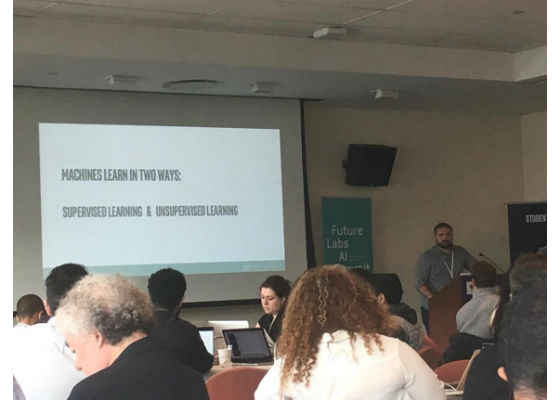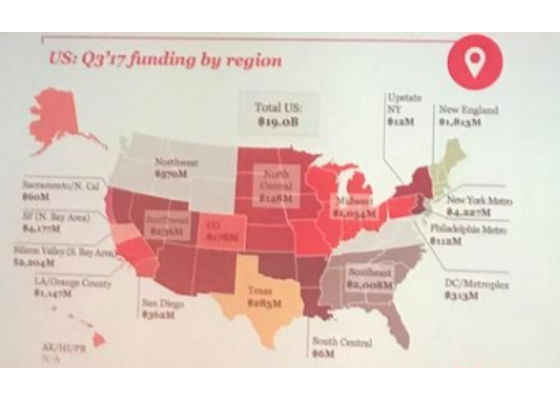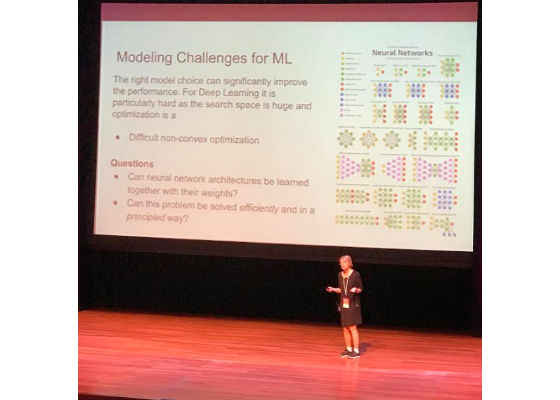Future Labs AI Summit at NYU – Fall 2017

The top minds in the development of Artificial Intelligence technologies came together at New York University to discuss the current and future advances and applications of Artificial Intelligence. Intel® Student Ambassadors Pallab Paul and Teju Tadi share their feedback and takeaways from this two-day event which included trainings, talks, and panel discussions with industry experts.
 Survey
SurveyTeju: The event was a great learning experience. The conference had the brightest academic and business minds in attendance all to speak about various topics surrounding Artificial Intelligence (AI) including harnessing the power of neural networks, investment in AI, and startups with innovative solutions in the industry. The conference also had some of the hottest startups in the AI space which were a part of the AI NexusLab startup accelerator program including: Bowtie, SecondMind, Mt.Cleverest, and Bite.ai.
Pallab: I met many people who were either working on AI related projects or who were AI enthusiasts. It was an amazing learning experience and I am grateful for the Intel® Student Developer Program for inviting me to attend this conference. The event was split up into two days, the first day being a day full of hands-on training and demos from experts and professionals, and the second day was full of guest speakers talking about the AI related projects they are working on and the future of AI.
T: The technical sessions on the first day allowed me to get some hands-on experience working with image-based Machine Learning (ML) and Deep Learning (DL) tasks. Karl Fezer, the AI Community Manager at Intel, had a great session explaining the difference between ML and DL. According to the presentation, in ML an algorithm is given large volumes of data to process and learn from. In ML the algorithm is learning from existing examples to solve new but similar problems. DL is a type of ML inspired by the biological connectivity within the human brain. DL instead utilizes neural networks. The session also discussed the relation between deep learning, supervised learning, back propagation, stochastic gradient descent, activation function, and basic linear unit.
P: I really enjoyed learning from Karl’s demo, not only because he is from Intel, but also because I have previous experience training a convolutional neural network (CNN) while creating my app ‘Face It’ which uses a CNN to detect face shapes. I was able to easily follow along and understand everything he was teaching about training the MNIST dataset on CNN. Also, as a representative for Intel, I helped Karl with his lesson by answering any questions people had on what he was teaching and what was going on. Overall the session went very smoothly and Karl did a great job presenting the lesson. I also learned some new things including information about various optimizers and the differences between them.
T: The presentation was followed by a workshop in which everyone was able to learn how to properly build and train a CNN to identify images. The exercise utilized Intel® optimized distribution for Python and TensorFlow, Numpy, Scipy, Scikit-Learn, and Jupyter Notebook.
T: Over the past few years, AI has been receiving significant attention in the media because of its extensive potential in nearly all industries. AI has become an industry buzz word in the tech space and investment in startups utilizing AI has gone up simultaneously in 2016 and 2017. Q4 2015 saw investments in the space at around $520 million. 2016 saw quarterly investments ranging from $750 million – $950 million. 2017 has seen an average of over a $1 billion dollar per quarter in investments in AI. The growth in AI related startup investments demonstrates the significant size of the industry as well as the rise of innovative solutions in the industry. The use of AI is not limited to a specific industry. As demonstrated by the chart below the current use of AI by startups and companies by industries is divided well.
T: Silicon Valley and San Francisco are considered the hubs for technology companies and the latest startups. The same is thought to be for AI related startups. However, in recent years the trend has been shifting. New York is experiencing a tech boom and is becoming a large hub for startups. One reason startups are attracted to New York is because it has a plethora of talent in various industries including finance, fashion, media, marketing, and commerce. New York has beneficial city and state policies as well as generous tax credits for tech companies. New York and the greater city area are also located near many great schools with an abundance of talent. VC Funding across various regions can be seen below. In fact, the New York Metro area is number one in terms of VC funding with over $4.227 billion dollars in funding. San Francisco is second in terms of VC funding with $4.177 billion dollars in funding. Silicon Valley is third with just $2.204 in VC funding. The numbers evince the fact that New York is now ahead in terms of VC funding for startups.
P: During the second day of the conference, many guest speakers presented their AI related companies, research, and work. Some of these guest speakers included Corinna Cortes from Google who spoke about Harnessing Neural Networks and how Google is using machine learning to create smart replies, James Villarrubia who spoke about his startup Mt.Cleverest, Vinay Anantharaman who presented his idea Bitesnap, Ron Fisher who talked his AI receptionist Bowtie, and Kul Singh who spoke about his brilliant idea Second Mind.
T: It was interesting to hear from Corinna Cortes, the head of research from Google NY. Cortes spoke about how Google is using the latest advances in neural networks specifically Long Short-Term Memory (LSTM) to implement and improve the Smart Reply feature in Gmail and Google Allo as well as Google’s speech recognition technology.
P: I found Corinna Cortes’ talk very interesting and educational. She started off by talking about how machine learning is being infused with many different types of applications and programs at Google and how much of a significant role it has in everyday technology. She explained how Google has been using machine learning for Google Translate, Google Photos, and Gmail. I was very surprised because I knew that Google was using machine learning but I didn’t know that they were using machine learning for almost all their applications.
After this, Ms. Cortes started to explain the process of how Google Smart Replies on Gmail are formed. She began by explaining how Smart Replies were inspired by Google’s 2009 April fool’s day joke that detected the contents of a message and generated an automatic response that the user would not want to normally say as a response. She then started to elaborate on Google’s Smart Replies and began explain how LSTM neural networks are used during this process.
P: LSTM neural networks are a special kind of recurrent neural network (RNN). Common RNN’s constantly loop the information that is being presented to it allowing them to pass this information from one step of the network to the next. A drawback of a regular RNN structure is the fact that it is not capable of learning long-term dependencies such as certain parameters specific to a certain problem.
LSTM’s solve this issue and are designed to remember information for long periods of time so that they can take these parameters into account and apply them for new tasks that are being presented to it.
P: Overall, Ms. Cortes did a great job presenting and I learned a lot of new information about artificial intelligence and machine learning.
T: New York has become a hub for AI because of the rise corporate research labs in the city such as Facebook’s Artificial Intelligence Lab.
The greater New York City area as mentioned previously has an abundance of great universities as well as leading AI researchers. The number of fortune 500 companies and their vested interested in AI has also helped spur VC funding for startups in the area. All the funding combined with the great number of startups has also lead to many open positions in jobs with AI, DL, and ML. New York is leading the country in terms of employment opportunities for AI with over 8000 openings.
T: It was very interesting to hear directly from innovative startups in the AI space. Bowtie, Secondmind, Mt.Cleverest, and Bite.ai were all present at the conference. The startups are a part of the AI NexusLab which is a four-month accelerator program that is run by NYU Tandon Future Labs and ff Venture Capital. Many of these startups are utilizing the latest advances in deep learning to improve everything from the customer relationship management, education, and the fitness industry.
P: I found the presentation from Vinay Anantharaman of ‘Bitesnap’ very interesting as it’s similar to a project I’ve been working on. His start-up uses machine learning, specifically a CNN, to detect every type of food item on a person’s plate so that they can keep track of all the food that they eat. I thought that it was a great idea, and very similar to a project I created called the ‘AI Calorie Counter’. Like Vinay’s app, mine detects a food item, but it detects it in real-time and can only detect one item at a time.
T: Bowtie allows businesses to develop and implement an AI receptionist over text, which can be used to book appointments, buy products, and get answers to any questions they may have. The receptionist handles any calls that the company may miss because of busy time periods. This allows the business to retain and create more customers, as well as to more revenue.
Second Mind enables conversations to visualized and transcribed. A vast amount of knowledge is exchanged in between people on a day to day basis. Often every detail in a conversation may not be retained. If the detail or information missed is critical it can detrimental to a business. Second Mind solves this problem by recording every conversation and essentially allows customers to derive key details from a conversation via a simple search.
Mt. Cleverest creates quizzes and tests based on material found online. There is a vast amount of information online that teachers are unable to utilize to the same extent as a textbook. By generating materials and examinations for teachers it allows them to not only grade exams quicker, but it also allows them to easily use the vast amount of resources online as material for the classroom.
T: It was a great learning experience attending the conference. Thank you to Intel’s Student Ambassador Program for allowing me to attend this exciting event.
P: Overall, I had a great experience at the Future Labs AI Summit in New York and I loved learning about AI during both the hands-on portion of the event and the guest speaker portion of the event. It was a very organized event and guests such as Karl Fezer, Corinna Cortes and Vinay Anantharaman did a great job presenting. I believe that the AI community in New York is strong and that it will only keep growing. I am fortunate enough to live along the east coast near New York and I hope to continue to contribute to the AI boom.
For more such intel IoT resources and tools from Intel, please visit the Intel® Developer Zone
Source:https://software.intel.com/en-us/blogs/2017/12/14/future-labs-ai-summit-at-nyu-fall-2017









